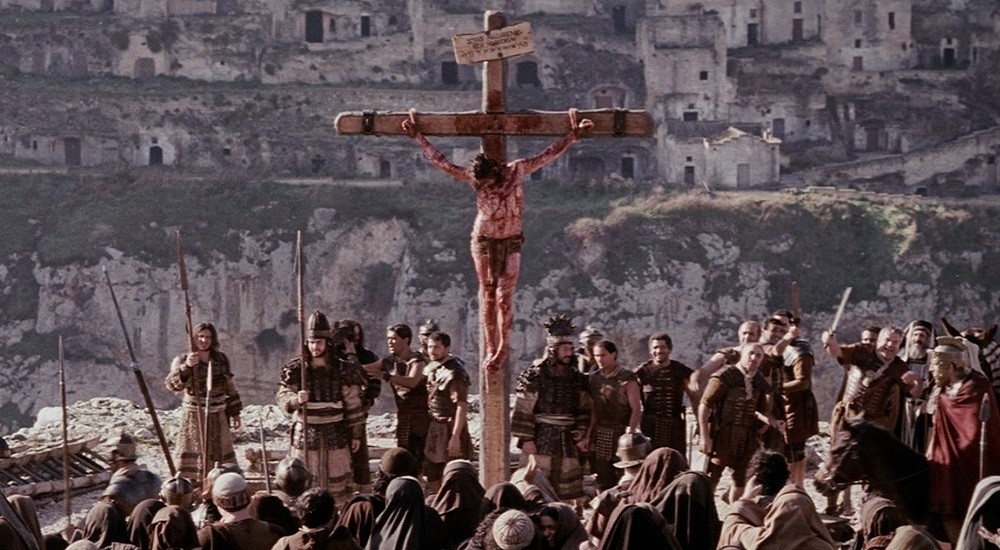The Passion of the Christ (2004)

The Passion of the Christ (2004) – A Profound and Emotionally Charged Cinematic Masterpiece
The Passion of the Christ, directed by Mel Gibson and released in 2004, is a deeply powerful and immersive portrayal of the last 12 hours in the life of Jesus Christ. It is a film that transcends the boundaries of conventional religious storytelling to become an unforgettable cinematic experience that explores themes of sacrifice, love, redemption, and human suffering with an intense rawness rarely seen in mainstream cinema.
Story and Narrative: The Ultimate Sacrifice
At its core, The Passion of the Christ focuses on the final hours of Jesus’ earthly life—from his arrest in the Garden of Gethsemane to his crucifixion and resurrection. The narrative closely follows the accounts from the canonical Gospels in the New Testament, yet what sets it apart is the unflinching and meticulous attention to the physical and emotional torment that Jesus endures.
The film portrays a sequence of events filled with heartbreak and brutality: Jesus’ betrayal by Judas, the harrowing trials before Jewish and Roman authorities, the scourging at the pillar, the crown of thorns, the carrying of the cross, and finally the crucifixion on Golgotha. These moments are not only graphic but laden with spiritual significance.
Mel Gibson invites viewers to experience the suffering of Jesus viscerally, as the pain and humiliation become almost tangible. Through this lens, the film emphasizes the depth of Jesus’ love and his willingness to sacrifice himself for humanity’s sins. The passion becomes more than just historical or theological narrative—it becomes a profound meditation on human suffering, redemption, and hope.
Direction: Mel Gibson’s Bold Vision
Mel Gibson, widely known for his acting career prior to directing, took a courageous and visionary approach in The Passion of the Christ. His decision to depict the story in the original ancient languages of Aramaic and Latin—rather than English—adds authenticity and immerses the audience in the historical context of first-century Judea.
Gibson’s directorial style is characterized by its stark realism and relentless intensity. The film’s visuals are often raw and unvarnished, avoiding romanticizing or sanitizing the narrative. The dark, earthy tones of the cinematography emphasize the grim reality of the events, and the lighting contrasts starkly between the shadowed scenes of suffering and the moments of spiritual revelation.
The pacing of the film is deliberate, sometimes slow, allowing the weight of each moment to settle on the audience. There is an almost ritualistic rhythm to the storytelling, which amplifies the emotional and spiritual gravity of Jesus’ ordeal.
The director’s choice to focus so heavily on the physical suffering—showcasing the brutality of Roman punishment methods—was controversial, but undeniably effective in conveying the magnitude of the sacrifice being made. This unyielding portrayal challenges viewers to confront the pain and injustice rather than shy away from it.
Performances: Jim Caviezel’s Haunting Portrayal of Jesus
One of the most critical elements that elevate the film is Jim Caviezel’s deeply affecting portrayal of Jesus Christ. Caviezel embodies the role with an extraordinary combination of vulnerability, strength, and quiet dignity. His physical transformation was rigorous, enduring hours of makeup and prosthetics to simulate wounds and scourging.
His performance is notable for its emotional restraint yet powerful expressiveness—communicating profound suffering without excessive dialogue, relying instead on facial expressions, body language, and silence. Caviezel’s ability to convey both the human pain and divine purpose of Jesus grounds the film’s emotional core.
Supporting roles contribute significantly as well. Maia Morgenstern’s portrayal of Mary, the mother of Jesus, offers a poignant glimpse into the grief and helplessness of a mother witnessing her son’s torment. Monica Bellucci as Mary Magdalene and Christo Jivkov as Joseph of Arimathea add layers of compassion and humanity amidst the brutal narrative.
Cinematography and Music: Heightening the Emotional Impact
The visual and auditory elements of The Passion of the Christ work in concert to create an immersive and haunting atmosphere. Cinematographer Caleb Deschanel uses close-ups to capture the intense emotional states of the characters and wide shots to portray the scale and desolation of the events.
Scenes of nature—such as the olive trees of Gethsemane or the dawn skies—provide a counterpoint to the grim events unfolding, symbolizing hope, renewal, and divine presence. The use of shadow and light reinforces themes of darkness and redemption.
John Debney’s musical score underlines the emotional landscape with a blend of mournful and spiritual motifs. The music swells in moments of tragedy and quiets to delicate whispers during reflective passages, guiding the viewer’s emotional response and complementing the visuals without overwhelming them.
Religious Significance and Universal Themes
While the film is explicitly rooted in Christian theology, its impact goes beyond a single faith tradition. The Passion of the Christ explores universal themes of sacrifice, forgiveness, love, and the endurance of the human spirit in the face of suffering.
At its heart, the film poses profound questions about the meaning of faith and redemption. It challenges viewers to consider the cost of forgiveness and the power of love that endures beyond pain and death. In doing so, it appeals not only to religious audiences but to anyone interested in the human condition and spiritual reflection.
The portrayal of Jesus’ willingness to embrace suffering for the salvation of others serves as a timeless metaphor for selflessness and compassion in all cultures.
Controversies and Criticism
Upon release, the film sparked widespread debate and controversy. The graphic depiction of violence, including intense scourging scenes, made many viewers uncomfortable and raised concerns about the film’s suitability for some audiences.
Some critics argued that the focus on brutal physical suffering overshadowed other aspects of Jesus’ teachings and life, leading to an imbalanced representation. Others voiced apprehension about potential anti-Semitic interpretations, as the film’s portrayal of certain Jewish leaders and crowds was seen by some as reinforcing negative stereotypes.
Despite these criticisms, many praised the film for its artistic bravery and theological depth. It was recognized for bringing a renewed attention to one of Christianity’s central stories in a way that was both emotionally impactful and thought-provoking.
Cultural Impact and Legacy
The Passion of the Christ achieved remarkable commercial success, grossing over $600 million worldwide on a modest budget, which underscored the widespread interest and resonance the story still holds.
The film reinvigorated the genre of religious cinema and influenced numerous subsequent projects dealing with faith, spirituality, and historical religious narratives. It inspired discussions in both religious and secular circles about the representation of sacred stories in modern media.
Additionally, the film’s influence extended to educational and devotional contexts, with many churches and faith communities using it as a tool for reflection during Easter and other religious observances.
Conclusion: A Cinematic Journey into the Depths of Human and Divine Love
In sum, The Passion of the Christ stands as a monumental achievement in modern filmmaking—a film that dares to confront the darkest moments of human history with honesty and reverence. Mel Gibson’s vision, Jim Caviezel’s poignant performance, the evocative music, and the compelling visuals combine to create an experience that is both harrowing and uplifting.
It invites viewers to grapple with questions about suffering, sacrifice, and the nature of love, providing not only a retelling of an ancient story but a spiritual journey that resonates deeply across time and culture.
For anyone seeking a profound, moving, and unforgettable film experience that explores the essence of faith and humanity, The Passion of the Christ remains a must-watch cinematic masterpiece.











